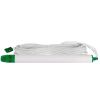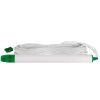Proactive Low Flow with Power Booster 2 Controller
Features
- User can precisely control the water discharge with the turn of a knob
- Used to monitor and regulate low flow sampling as low as 40mL/min
- Includes 7' wire lead to battery clamps and 8' wire lead to pump connector
- Free ground shipping
- Expedited repair and warranty service
- Lifetime technical support
- More
Overview
The Proactive Low Flow with Power Booster 2 Controller is engineered specifically for the Tsunami, Monsoon, Hurricane, and Supernova 120 high-performance pumps.
Mechanics
With the Low Flow with Power Booster 2 Controller, the user can precisely control the water discharge with the turn of a knob. The Low Flow Sampling Controller is used to monitor and regulate low flow sampling as low as 40mL/min.
Benefits
- Engineered with reverse polarity protection
- Advanced thermal overload protection
- Heavy-duty steel weatherproof case
- Low voltage disconnect (LVD) at 10.75 volts (turns off the controller or allows the pump to pulsate)
- Constant Voltage Boosting Technology (CVBT) allows the correct voltage to reach the pump motors
- 25 AMP "safety" fuse to protect electronics and user
- 6-month parts and labor warranty
- 'Ramp Up' control dial
- The 3-foot wire leads to battery clamps, and the 5-foot wire leads to the pump connector
- Steel handle for comfort and control
In The News
Rounded pebbles give evidence of past flowing water on Mars
NASA's Curiosity rover has found pebbles that appear to have been rounded by streamflow, according to a release from University of California Davis. Experts say the finding represents the first on-site evidence of sustained flowing water on Mars. The rounded pebbles discovered are only known to form when transported through water over long distances. Their discovery supports theories that the red planet could once have supported life. The smooth rocks were found between the north rim of the planet’s Gale Crater and the base of Mount Sharp, a mountain inside the crater. Researchers say they chose Gale Crater for study because there was a sediment deposit there that typically requires water to form.
Read MoreStudy suggests small dams have more negative effects than large dams
A recent study suggests that small dams may have a greater impact on rivers than large dams, as they divert more water away from rivers, according to a press release from the American Geophysical Union. Researchers from Oregon State University studied China’s Nu River, which is home to a variety of dams in the river main stem and its tributaries. In total, 31 small dams were evaluated and compared to four large dams in the main river stem. The research team compared dam impacts to habitat loss, river channel lengths, land affected and landslide risks among 14 total factors. They found small dams had a greater negative impact in nine out of 14 categories. Small dams, used to divert water to hydropower stations, had some of the most profound impacts on rivers.
Read MoreU. Delaware studying tidal flow, sediment movement in salt marshes
University of Delaware scientists are studying the impacts that rising sea levels might have on marsh ecosystems in the future, the University of Delaware has reported. Scientists predict that rising sea levels could convert marshes into intertidal flats. These conversions could drastically change land composition by stripping sediment from the land, which could alter water quality by exposing substantial quantities of sequestered carbon and pollutants. Researchers are monitoring the fluctuations of water flow and sediment concentrations in Delaware’s Brockonbridge Marsh.
Read More












